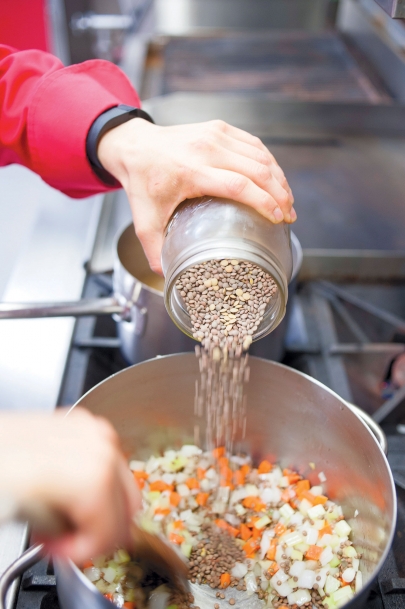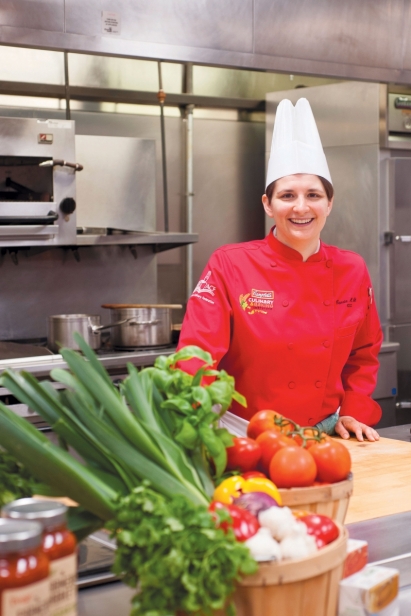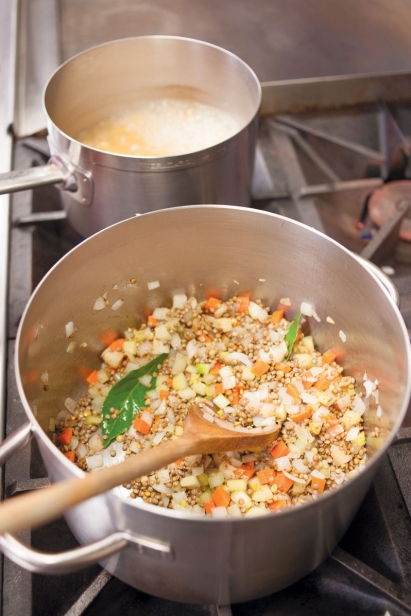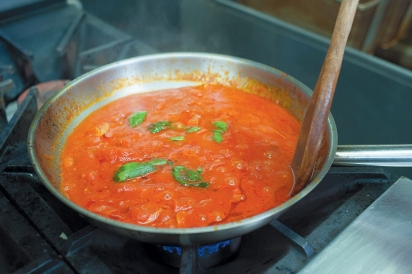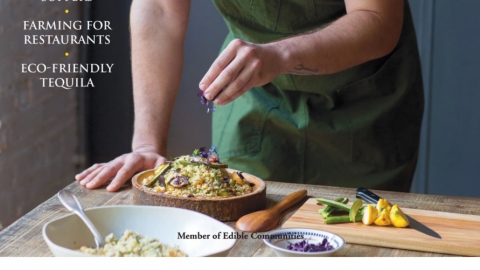From Chef to Shelf
How Carrie Welt, a member of Campbell Soup Company’s core team, brings a new recipe to life
In one of Campbell’s test kitchens at its Camden, New Jersey, headquarters, chef Carrie Welt scoops harira, a Moroccan soup traditionally made with chickpeas and lentils, into three small bowls using a miniature ladle. It’s a beautiful cooking space with a large stainless steel French door refrigerator, a long, empty marble countertop and a five-burner range with a professional vent hood. Welt looks right at home.
An energetic 37-year-old with short brown hair peeking out from her toque, Welt is part of the Campbell’s Culinary Baking Institute (CCBI) core team. Its members are floaters who can jump into any project that requires the skill set of a professional chef, within any of the company’s 17 brands. Welt’s experience and know-how lead to products like the lentil soup we’re about to try. The soup is flavorful and warm, with few enough chunks to keep it squarely out of stew territory but plenty to entice you to take another bite.
Bringing a soup to market is a long process; something Welt conceives of today likely won’t be on store shelves for at least two years. It involves a germ of an idea, getting the go-ahead to create, the creative process itself, consumer testing, recipe tweaking, a little chemistry, a whole lot of teamwork and so much more. “Most of the stuff I’ve actually worked on . . . isn’t out yet,” she says.
A Stroke of Luck
Though Welt has been with Campbell for three years, she still describes herself as a recent transplant to Philadelphia. She came by way of Tennessee (her home state), then studied at the Culinary Institute of America (CIA), where she stayed for an extra year to complete a fellowship in meat and fish fabrication. “You want to know how to cut a salmon? I’m your girl,” Welt says. “I can still rattle off the eight identifying characteristics of cod.”
She moved through several fancy hotel restaurants, including the Inn at Dos Brisas in Houston, Texas, and Blackberry Farm in Walland, Tennessee. When she hit what she describes as the “grill ceiling”—never being trusted to cook the meat proteins like her male counterparts were—she went back to school, earning her master’s degree in management in hospitality from Cornell.
For the next six years—three at the United Nations, three at the independent New York City caterer Great Performances— she managed large kitchens and oversaw a team of cooks. Great Performances provides food for the annual American Heart Association’s Red Dress Awards. It was at that event that Welt bumped into certified master chef Thomas Griffiths, CCBI’s global vice president and one of her former CIA instructors.
“What has always impressed me about Carrie is her very positive personality,” Griffiths says. “She lights up the room. And obviously her outstanding culinary skills. Carrie has worked at some of the finest restaurants in America.” Just seven months after that fortuitous meeting, Welt started working at Campbell’s.
Soup Wish List
Being a core team member means her schedule changes weekly, even daily. “Some days I work for Prego and Pace, some days I work for Swanson. Some days Plum Organics says, ‘We’re interested in doing this top-secret thing over here. Can we get your input?’” she explains. “I flow to wherever they need me.”
One such top-secret assignment has since gone on sale: Prego Farmers’ Market pasta sauces. During the summer months, Welt would often hand-crush tomatoes she purchased from her local farm stand; those heirlooms became the inspiration for a novel product line. The texture and ingredient composition of the new jars differ from traditional Prego sauces, giving them a more homemade feel, she says. “I am delighted with the results,” she adds.
Welt has such pizzazz that it’s hard to imagine her not thrilled. When she discusses something she helped create, she’s humble and modest, excited and energized, serious but proud. This jumble of emotions comes out—in a collected way—when she details the lentil soup.
It all began with a version of the harira she cooked for me in the test kitchen.
Away From Home, what is today Campbell’s Foodservice business, works with institutions like schools and restaurants. It was also one of Welt’s first posts when she joined the $8 billion company in 2012. At that time, the Away From Home chefs decided they would write down a soup wish list: 15 ideas each they really loved. Those dream lists got whittled down to 10 each, then the cooks prepared all 30 remaining contenders for a marketing taste test that would result in several soups moving forward. One of those was a vegetarian option starring lentils and chickpeas that Welt conceived from the harira. It made the cut.
When one Away From Home customer (Campbell’s wouldn’t say who) asked specifically for a soup with kale, Welt knew her new lentil base would work well. To the original recipe, she swapped in red lentils for brown because of the former’s shortened cooking time, added in a little cream, and left the chickpeas alone.
That last move solved a practical problem: “You can’t get kale without stems . . . so you’re going to see it sometimes in the soup,” she says. The chickpeas helped compensate for such a large and crunchy item. “The size difference is a lot more palatable to people because then they perceive, ‘I’m eating something that’s already got a sizable crunch.’ That makes the kale stem a much easier thing to take.”
Welt worked on the Away From Home version for more than a month. “It was my lunch every day for 33 days. By choice,” she explains. “I even took it home with me on weekends.”
A Third Tweak, Then Onward to the Shelf
Foodservice products aren’t sold in grocery stores, but given the success of Welt’s lentil soup, Campbell’s opted to have her make a variety it could sell as part of the brand. She tweaked the soup for a third time. “We wanted to see if we couldn’t translate it into a new organic brand that was shelf-stable,” she says, “so we switched back to the original brown lentil instead of the red because that holds up better in our manufacturing process.”
Today it’s called Campbell’s Organic Lentil, appearing not in that recognizable split red-and-white can with the emblazoned logo but in a box, the logo still present atop a large, green “ORGANIC.” Welt modifying her recipe was the first step in a long line to get it there. Once a chef feels confident about a recipe, having created the gold-standard prototype using top-of-the-line ingredients, she converts them to supplies the procurement department can easily get.
Campbell’s technologists smooth a product’s edges—making sure the recipe works with the intended bottling, for instance—and scale it up for manufacturing, paying attention to factors like “food safety, cost, ingredient availability and myriad other things I have yet to comprehend,” Welt says.
They also handle the packaging. Sometimes in this phase, chefs work with the company’s technologists to maintain a food’s flavor, like with certain Pace salsas that need just the right acidity level to keep the food safe and still work in the production process. Other times chefs hand off a prototype and move on to something new. Brand marketers also participate, often having been the impetus for the product in the first place.
Along the way, consumers voice their opinions, too. Every item goes through consumer taste tests of one kind or another. And what the consumer groups say matters: Welt mentioned one item on the docket for consumer testing the following week; if the people didn’t like it, the product would likely not get the green light.
Despite the seeming power of the taste-testers, there’s little room to get offended during the process. “You can’t take these things too personally,” Welt says. “You have to understand that the consumer comes first and it’s what their opinion is. Also, just because the loudest person didn’t like it doesn’t mean [nobody will like it].”
Unintended Perks
Working for a large company like Campbell’s has its perks. Though each brand’s ideal consumers are firmly established, food creators have leeway to play around with what might work for those people. CCBI closely watches the food world, creating an annual “Culinary Trendscape” in which it ranks items on a continuum from one to six, the low end meaning something to keep on a radar, the high end being a trend already visible in grocery stores. This year’s top-ten list included “authentic Thai” (a two), “Asian noodle soups” (a four) and “caramel” (a six).
“You’ve got to wait to see if [a trend] is going to catch on long term. But it can open us up to very interesting things,” Welt says. For example, in 2015, Filipino flavors earned a one in Campbell’s Trendscape, but calamansi limes—prevalent in that cuisine—were everywhere. So the CCBI chefs worked with King Phojanakong, owner-chef of New York’s Kuma Inn, to learn about the culture’s important flavors.
They also took care to understand the different uses for Mexican and Filipino adobos. In Mexico, “adobo” is a puree made from dried chilies, garlic, spices and sometimes vinegar that often becomes a marinade for meat. In the Philippines, “adobo” refers to both the cooking method and the dish, Welt says, indicating the use of vinegar for braising. “We know we can keep it on the backburner. This [Filipino] adobo might be something we want to look into down the line, in awhile,” she adds. “Not right away.”
Sometimes the chefs travel for inspiration. In 2014, Welt spent five weeks in China: three for vacation, two for work. She took a cooking class; learned the flavors of Cantonese, Sichuan and Beijing cuisines; and returned home with ideas that have already become prototypes. In early 2016, Griffiths and other Campbell’s team members went to Thailand, where they brought back information about local ingredients like durian (a terrible-smelling, sweet-tasting melon) and longan (a fruit in the lychee family).
Local Pride
Despite experiencing these cuisines abroad firsthand, Welt seems like she’d be perfectly happy exploring Philadelphia for ideas, especially as its foothold as a great food city grows. “Nobody seems to love food the way Philly does,” she says.
With Campbell’s headquarters just over the Ben Franklin Bridge, the Philadelphia food scene has certainly bled into how its chefs create. But, without question, Campbell’s takes pride in Camden, its home for almost 150 years. The first plant opened there in 1869; the inaugural canned soup went on sale in 1895.
In 1911 the company started distributing nationally, but Camden was already fused into Campbell’s institutional identity. Other businesses are sprouting up there today—Subaru recently held a groundbreaking across the street—and Campbell’s itself is investing in the area with Healthy Communities, a program aimed at improving young people’s access to nutritious foods. (See the sidebar for details.) For Welt’s part, she seems to love what she’s doing and where she’s doing it. Though she admits to missing the high of working in a fast-moving, high-pressure restaurant kitchen, she gets some of that through the other part of her job: handling corporate events where she gets to show off Campbell’s new releases.
It’s a far cry from her first food foray slinging fries. The organization has high hopes for her, too; Griffiths told me they’d like to mold her into one of Campbell’s global culinary leaders. As Welt buzzes around the model kitchen, seamlessly describing her resume and the company’s process while making the stir-fry we’ll eat for lunch, that’s not hard to imagine. With her in that role, many more new Campbell’s products will make it from idea to package and onto store shelves.
Local Immersion
“There’s something very powerful about food—it has the ability to connect people from all walks of life,” writes Kim Fortunato, Campbell Soup Foundation president and director of community affairs, in a blog post. “As a food company, we believe we have a duty to give back to the communities where we live and work.”
That’s the premise behind Healthy Communities, a 10-year, $10 million program that Fortunato helped launch in 2011 and still runs today. The program’s aim is to cut childhood obesity rates by 50 percent in Camden, where the company is based— and one of country’s poorest cities—as well as in other areas with a Campbell’s presence like Norwalk, Conn., and most recently, Detroit.
The multi-pronged approach includes increasing physical activity for children, educating families about nutritious eating and ramping up fresh options in places with limited grocery stores. “Our corner stores are a primary source of food in our food system in Camden,” Fortunato says. So that’s where the Healthy Corner Store Network began.
Since its inception, that program has enrolled 30 percent of the city’s 123 bodegas and corner stores. Every participating owner gets a $100 incentive and technical assistance from the Food Trust, a nonprofit organization focused on improving access to healthy foods, on anything from refrigeration techniques to nutrition. “They’re taught how to market fresh produce,” Fortunato says. For example, “If it’s ripening you’d do fresh, cut-up fruit; if it’s even more ripe you can do smoothies.” Through an athletic program called Soccer for Success, Healthy Communities logged more than 107,000 hours of physical activity in four years. The group has partnered with a medical school and the Camden City School District, among others to improve health and wellness education.
“The role that we’ve taken is a very engaged role rather than just a check-writing role,” Fortunato says. In the second five years, she adds, Campbell’s plans to go even deeper, bringing nutrition education to new outlets like a pediatric practice and continuing its work to improve food policies.
RECIPE


